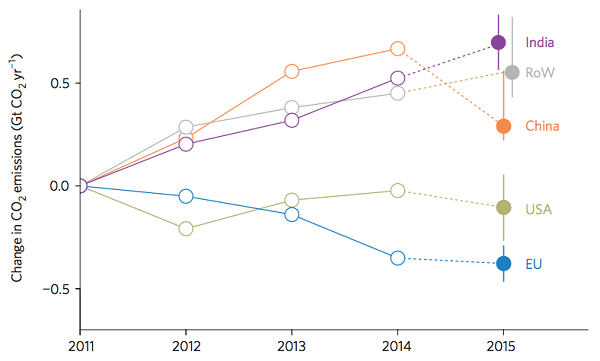1. Game changing steel to make lighter cars etc.
From Gizmag, courtesy of John D:
- Back in 2011, we wrote about a fascinating new way to heat-treat regular, cheap steel to endow it with an almost miraculous blend of characteristics. Radically cheaper, quicker and less energy-intensive to produce, Flash Bainite is stronger than titanium by weight, and ductile enough to be pressed into shape while cold without thinning or cracking. It’s now being tested by three of the world’s five largest car manufacturers, who are finding they can produce thinner structural car components that are between 30-50 percent lighter and cheaper than the steel they’ve been using, while maintaining the same performance is crash tests. Those are revolutionary numbers in the auto space.
2. What is really happening in Antarctica?
The short answer, according to Jonathan Bamber at RealClimate, is that we don’t know whether East Antarctica is gaining or losing mass.
- One other thing is certain: West Antarctica has been losing mass at an increasing rate since the 1990s and, irrespective of what is happening further East, that trend looks set to continue. Going to the other end of the Earth, the Greenland ice sheet has also been losing mass at an accelerating rate since around 1995. Greenland is now the single biggest source of mass to the oceans. These trends at both poles are huge signals that are unequivocal and uncontested.
3. James Hansen’s ‘Ice melt’ paper
In July this year James Hansen and 16 other scientists published a paper where the title carries the main message:
The paper was published without peer review in an ‘open review’ methodology. Go here to find scientists’ comments and author response.
Two months later James Hansen and Makiko Sato wrote a piece on the Predictions Implicit in “Ice Melt” Paper and Global Implications.
Their focus is on the Antarctic and Greenland ice sheets. They predict a doubling of ice loss every 10 to 40 years, with the likelihood resting towards the lower end of that scale. West Antarctica has 3-4 metres worth of sea level rise vulnerable to rapid melting. Greenland has at least two.
It’s really a matter of risk. The risk of multi-metre sea level rise in the next 50 to 200 years is unacceptable.
Brian Palmer has a handy comment on the paper.
One phenomenon worth noting is that they see ocean surface cooling from meltwater in the Southern Ocean and in the North Atlantic. This may be sufficient to effect the weather.

There was evidence of this warming effect in 2013-2015.
They call for monitoring of aerosols in the atmosphere, presently not done, and an extension of the Argo project to monitor the ocean at depth all over the world.
4. Global emissions fall in 2015
- Early estimates suggest that global emissions will decrease by 0.6% this year, following a small increase of 0.6% in 2014.
The rapid growth in global carbon dioxide emissions over the last decade appears to have stalled, a new study says.
Chinese emissions fell by 4% from 2014, largely because they are burning less coal.
Expert opinion seems to think, though, that a global peak is probably 15 years away. China, the US and the EU seem to be on a downward path. It really depends now on India and the ‘rest of the world’:

5. Images of sea level rise
From Climate Central Images Show Impact of Sea Level Rise on Global Icons
They claim the science is from NASA. These images from iconic sites such as London, Shanghai, Mumbai, Sydney, Rio de Janeiro, Durban and New York give cause for pause.

